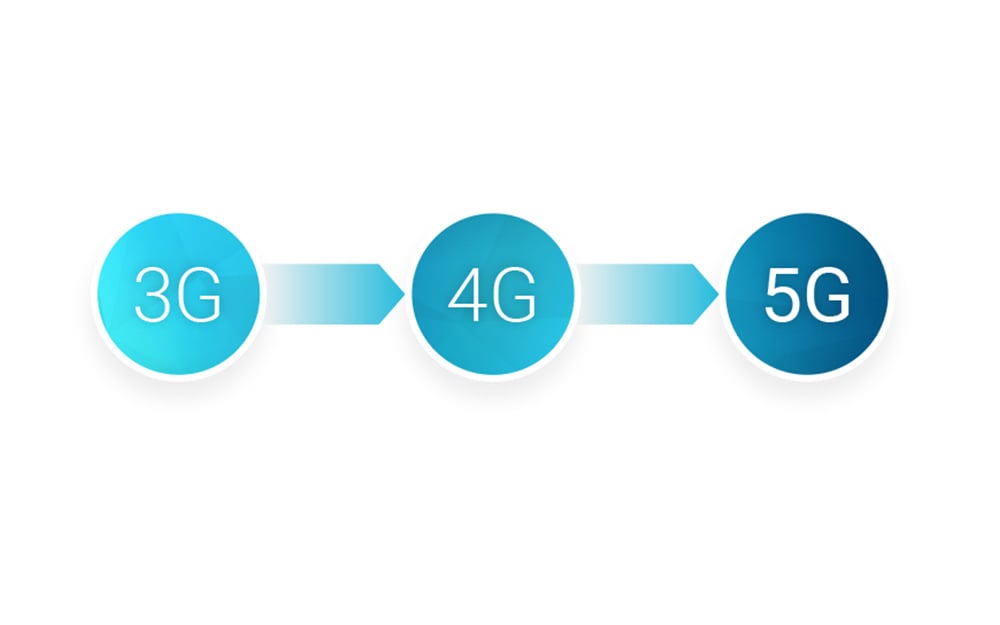

The move toward 5G
Enabling new services. Empowering new user experiences. Connecting new industries
What is 5G?
Every generation of mobile technology brings the promise of improved user experience and greater service innovation—and 5G is no exception. More bandwidth, more connected devices, lower latency, and a slew of cool new applications are taking mobile broadband to the next level with enhanced reliability and coverage. More than a network, it's a foundation for innovation.
But meeting the expectations of 5G will take more than just the next generation of radio technology. It also requires a new network that embraces virtualized, cloud-based solutions.
Rapid service innovation will require SDN, NFV and mobile edge computing.
Massive scaling of devices, traffic and services will require automation and ‘big-data’ analytics to manage complexity.
Does your network have the visibility needed to manage this transformation? Will you be able to keep your network operating at peak efficiency and continue to delight your customers?
EXFO has the expertise and solutions you need to make sure your network performs flawlessly as you embrace 5G and all its promises.


Challenges
How will the move to 5G impact networks?
Every generation of mobile technology presents challenges to integration. Along with a new radio interface, 5G brings about significant change in the way networks are built and operated. 3GPP R13 has already introduced new functional elements into the network. SDN, NFV and network slicing are key to managing complexity and scale, and mobile edge computing will be needed to address latency concerns.
Managing change without impacting existing services will be key to a successful transformation.
Transformation to SDN/NFV
5G is more than simply a new radio interface. To support the scale of services and devices expected, the 3GPP has redesigned the network core to leverage SDN/ NFV technology to provide a scalable, agile infrastructure. Networks are expected to have hundreds of different network slices to manage everything from quality of service to traffic separation. SDN/NFV is also necessary to support mobile edge computing (MEC), essential for providing 1 ms round trip latency for extreme communications services.
Having the tools and visibility in place to support 5G rollouts by 2020 requires a new way of looking at service assurance and performance monitoring. Rather than part of the network infrastructure, these tools must be part of the service definition.
Transitioning to a new network
How do you ensure the new 3GPP functional elements will handle the scale of deployments expected before trying them out in the live network? How do you guarantee services will continue to operate without issue during the upgrade? The path to a smooth transition requires an investment in testing and validation that starts with the equipment manufacturers.
Simulating entire hybrid LTE/5G networks to see how a new platform performs is essential to building the confidence needed to move forward. Knowing that new protocols and functionality have been fully exercised, at scale, is a critical check point before touching the live network.
Finally, having real-time visibility into the performance of existing and new services, during this transition period and after, provides the assurance your operations team need to key your customer happy.
Massive scale of connected devices
5G is being positioned as an enabling technology for service innovation. Not just a new radio interface for better throughput and latency, but also a core network that leverages the latest ideas in scalability, agility and performance. Of course, applications such as IoT, with it’s massive scale, are being addressed. But more than that, 5G’s architecture will serve as an innovative platform upon which forward thinking developers can create new, unforeseen services on a scale never before imagined.
The challenge to service providers will be to scale, or perhaps more appropriately, adapt their operations to keep in step. Massive scale requires automation at all levels, from infrastructure build out to new service provisioning to troubleshooting and repair.
Carriers that are not prepared to invest in automated operations will be left behind. Without orchestrated field test solutions, real-time active monitoring and data-driven analytics to process the billions of KPIs generated annually, a successful transition to 5G is not possible.
Keeping the customer happy
For service providers, there is only one true measure of success—customer satisfaction. In the end, the customer doesn’t care about the technology used to deliver their service. They only care that their service delivers what was promised. The shift to virtualized networks makes this even more critical since automated, dynamic service creation means customers can change providers very easily. Customer retention becomes solely dependent on the customer's quality of experience (QoE).
For 5G networks based on SDN/ NFV networks, the task of keeping customers happy means continuous, active monitoring of the end-to-end services, in real-time. Having active service assurance as part of the service chain, for every service, ensures 100% visibility into the customer QoE, and therefore their satisfaction.
Latency for extreme communications
5G is not simply about a new radio interface with more bandwidth. It also addresses the latency concerns of several planned applications such as connected vehicles, real-time gaming, or remote video monitoring. These applications demand extremely low latency (< 1ms in some cases) to ensure the safety of passengers or to provide real-time high definition video for security surveillance.
Ensuring your network is up to the task of meeting this requirement means continuous, active monitoring of the end-to-end service in real-time. Advances in networking technology, such as virtualization mobile edge computing and network slicing, will enable ultra-low latency applications. Having performance monitoring as an embedded function of the service itself, rather than a network feature will provide the visibility needed to ensure these extreme services continue to exceed expectations.

Solutions
How will carriers benefit from 5G?
5G promises to revolutionize the way mobile networks operate. Capabilities like 1 Gbit/s to the device, 1 ms latency and five-9's availability provide a fertile breeding ground for service innovation. Traditional barriers to competition disappear as communications service providers become digital service providers and the distinction between content provider and network provider blurs.
Successfully navigating this change requires a whole new level of insight, built from the ground up to provide always-on visibility.
An engine for competitive differentiation
5G promises to dramatically change the cost structure of networks by leveraging the latest technology for virtualized networks. SDN/NFV leverages commercial servers to lower capital costs and move specialized functionality into software, making the core highly scalable and agile. Network slicing will lower operating costs simplifying service management and automation will drive operational efficiencies, making the overall cost to deliver and manage services lower than ever before.
At the same time, having a cost effective, operationally simplified, highly scalable network opens the door to a new model for service innovation. DevOps is essentially the process of building services in the live network with a lead customer concurrently validating functional fit. And since services are built using software virtualized network functions (VNFs) chained together, new functionality can be added by simply installing a new VNF.
This 5G enabled innovation platform will allow new services to be launched in days rather than months. Having full visibility into the performance of networks and services during a launch will be key to ensuring that existing services will not be impacted by the addition of one.
A new model for operations effectiveness
Because of its anticipated massive scale, 5G will have a heavy reliance on automation for commissioning devices, provisioning services and optimizing networks as well as detecting and resolving network and service issues. Ultimately, this automation will lead to fewer errors in provisioning and maintenance, faster root-cause analysis when issues do happen and self-healing networks and services through integration into orchestration platforms. Continuous service assurance monitoring, multi-dimensional analytics, spanning customer, network and service, and real-time KPI reporting means most issues can be resolved before the customer notices.
5G automation promises to lower the average cost of operations per service, improving your bottom line while at the same time providing your customers with a better quality of service.
DevOps-driven service innovation
Competition for customers is increasing. Virtualized networks and cloud based services have moved service creation into the software domain and enabled a DevOps approach to address new customer needs in days or weeks, rather than months or years. By allowing carriers to design tests and deploy new services in the ‘live’ network, lead customers can more easily beta test new services in a real-world scenario.
The key to DevOps is being able to closely test and monitor the service and network, in real-time while the service is being designed to ensure it meets the customer’s needs and does not impact other network services. Building service assurance into every service definition gives carriers 100% visibility into service and network performance.
Future-proof, scalable network infrastructure
It is anticipated that 5G networks will enable a massive growth in mobile services and bandwidth. The challenge to the mobile operator will be having a core network that can scale along with this growth, without having to overbuild in anticipation. This is one of the key drivers for implementing an SDN/NFV-based core network. By using commercial, off the shelf (COTS) hardware along with software defined functionality, growing the network capacity can be as easy as deploying additional servers and loading them with the right software.
Having a core that can quickly scale with demand allows carriers to build only what’s required, and being able to monitor the network and its services in real-time will be essential to triggering this growth and ensuring that service quality remains high.
IoT-ready network
5G and IoT were made for each other—literally. A significant amount of functionality is being included in the 5G specifications to support IoT. Everything from air interface standards for reach and power considerations to density of devices per square km to extremely low latency for delay sensitive applications are included. And the good news is, IoT deployments are anticipated to scale massively, with some analysts predicting 20 to 30 billion IoT devices in the network by 2020.
Managing this growth requires communications service providers to have complete visibility over how their networks are operating—in real-time and with near 100 % coverage. To do this requires a new way of working, including building service assurance into the service definition and having analytics-driven automation to address the scale of services being deployed and managed.
5G solutions
The move to 5G will radically transform networks and services, from core to edge. Virtualized network cores, leveraging SDN, NFV and network slicing. New radio technology enhancing both fixed wireless access and enhanced mobility. Broader reach with more bandwidth, lower latency and higher availability. Each of these will help open the floodgates of service innovation. Having full performance visibility will be key to a successful transformation. Does your network have the insight?
Test and measurement solutions
Modern carrier networks are built using millions of miles of fiber optic and copper cables. And as service rates continue to climb, carriers are demanding more and more from this investment. Many customer-impacting service issues can be traced back to quality issues on a fiber or copper cable. Whether it’s something that happened during construction (dirty connectors or a bad splice) or while carrying live traffic (cable break or a patch panel misconnection) or because of degradation issues (wet copper access cables) having the right test equipment to quickly detect and diagnose issues is essential to a quick resolution. And 5G networks are no exception—in fact, given the trend toward higher bandwidth and signal quality, many issues that were not detected in existing networks may become visible as the networks are upgraded.
As the leader in handheld optical test equipment, EXFO has the products and expertise you need to ensure your networks perform flawlessly.
Service assurance solutions
For networks built using SDN/NFV, like the 5G core, end-to-end service assurance must be an essential aspect of every service. In traditional, physical networks there is a direct mapping of service topology to network topology based on fixed or deterministic routing rules and policies. An SDN/ NFV network breaks this relationship by abstracting the service layer away from the physical infrastructure. Because of this, it is no longer possible to infer service quality from network quality.
By utilizing active, end-to-end service assurance techniques carriers can have a real-time view of the service performance, regardless of how the SDN network has routed/re-routed it. Additionally, as services are migrated to new VNFs, there is no need to modify the performance monitoring since it’s built into the service itself and, there will be no gaps in key performance KPIs due to the move.
EXFO has a wide range of active service assurance solutions, including advanced analytics and topology discovery tools to make every network 100% visible and enable carriers to see issues before their customers do.
Analytics solutions
It is expected that 5G core networks will have millions of services running in thousands of network slices implemented on thousands of servers connected with millions of miles of fiber. Additionally, it is expected that many software defined network services will be highly dynamic in nature, for example with more bandwidth available during non-peak network hours or simply very short lived–days or even hours.
Networks such as this have the potential to generate billions of KPIs per day. Making sense of this volume of data and looking for anomalies or trends requires analytics. Humans are simply not up to the task. Especially necessary, due to the dynamic nature of SDN/ NFV networks, is the ability to map out service topologies in the virtual network so that service issues on independent services can be correlated to enable rapid root cause analysis.
EXFO has the analytics and topology discovery tools needed to allow a carrier’s operations team to keep the network running flawlessly.
Simulator solutions
The evolution of mobile networks to support 5G represents a significant architectural change, which was first introduced in 3GPP release 13. Verifying that the new functional elements will work as expected and not negatively impact existing services is critical for a smooth transition. Testing new functionality in a live network would be too risky and building a test network of sufficient scale would be cost prohibitive. Network simulators provide a cost-effective, flexible and reliable way for new platforms, functionality and protocols to be designed and tested, including load or stress testing. In this way, network equipment manufacturers can be sure their solutions will not negatively impact the live network or existing services.
Resources
All resourcesLanguage
Resource type
